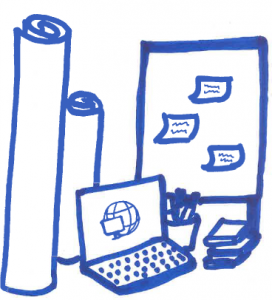You want to improve your media competence? You want to learn, how you can develop your school towards a modern learning culture? Good! Theoretically, you can do the modules in a random range. Let’s consider three main variants:
- Do the ICT modules at first. You get an idea about what is possible. Use this knowledge, when start developing your strategy to digitalise your school. Do the SSD modules afterwards. Meanwhile, check which of the ICT tools you want to implement in your school and involve it in your planning.
- Do the SDD modules first. If you are clear about the main directions of development, you may easier decide for relevant tools and learn more focused within the ICT modules.
- Mix up both modules. This may give you time to reflect on contents learned and which parts you might have to repeat or deepen. However, please consider that your training structure leaves a lot of time between single dates. Maybe you get confused, if you mix it up to much. We recommend choosing one of the first variants.
Imagine the case that the best time for you to find meeting date with your colleagues are Wednesdays and Saturdays.
| Wednesday 1 3 to 6 pm | Wednesday 2 3 to 5 pm | Saturday 9am-5pm | Wednesday 3 3 to 5 pm |
| ICT 1 | ICT 2 | ICT 3 and 4 | ICT 5 |
| Wednesday 4 3 to 6 pm | Saturday 2 9am-5pm | Wednesday 5 3 to 5 pm | Wednesday 6 3 to 5 pm |
| SDD 1 | SDD 2 and 3 | SDD 4 | SDD 5 |
Discuss in your team, what you want to implement and if you identified further gaps or topics, you want to care about. Prepare for the next part.
Make sure that the headmaster takes part on Wednesday 5. He or she is manager of the school and should be familiar with index numbers. He or she should also have the time to give you feedback on your work results between the meetings.
Prepare for the meetings. Between the presence dates, you have time to learn on your own. Each module has an estimated learning time up to 3 hours.
Build a Team. Find five to six persons from you school to do the training at the same time. You can learn as peer and develop your school’s strategy approach together.
Ensure support of your school principal. If you do not only want to learn something about digital media and strategy development, but change things, you need your headmaster as a committed decision maker.
Plan your work. Fix at least five dates before you start. Plan 2,5 hours for each. If you want to do both content strands combined with peer-learning settings, find approx. 10 dates. The training covers 40 working hours. You may need more. Please look on the module structure, before you fix the meeting dates.
Read your national digitisation plan (if there is any). You can look it on the internet. Find one example here. You need it to get an idea about the political course of national education ministries, because this may affect your school.
Document your development process. Your learning and developing process will produce documents and files, which you need for a transfer of your work to others. Use moderation technics to write down your ideas, take photographs or write a blog…there are many possibilities. Important is that you show, what you do.
Prepare your material. That means: enough notebooks, WiFi connection, moderation material (wallpaper, flip chart, permanent marker, sticky notes or moderation cards and pins) and projector. If moderation material is too expensive for your school, just use a big wall and sticky notes. Moreover, make sure that you have access to the teaching material on the Open Education Repository and a room, where you can meet and may leave your things.
You as a multiplier are responsible for the moderation of the meetings. Without a clear moderation, the process might get out of yours hands. Help the learners to find dates and organise the teamwork. You take over the role of a tutor, who supports the training process and ensures the quality of the results.










